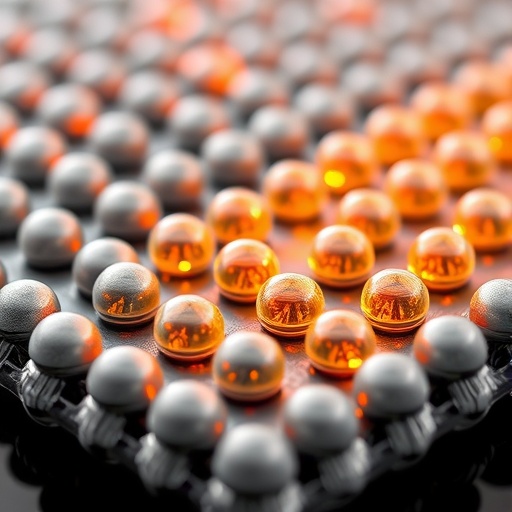In a groundbreaking study published in Ionics, researchers have unveiled the multifaceted electronic coupling mechanisms in palladium-silver (Pd–Ag) nanoparticles supported on nucleation-rich tungsten oxide (WO3). This investigation not only elucidates the intricate electronic interactions at play but also sheds light on potential applications in catalysis, particularly for ethanol oxidation, which is pivotal for various energy conversion processes and green chemistry applications.
Harnessing the unique properties of Pd–Ag nanoparticles, the research team aimed to explore how the electronic structure of these catalysts is modified when interfaced with WO3. The particular choice of WO3 as a support material stems from its well-known ability to provide a rich nucleation environment, which is essential for the stabilization and enhancement of the catalytic properties of nobler metal nanoparticles. This study delves deeply into the dimensions of electronic coupling that arise from the structural and compositional characteristics of the Pd–Ag system when integrated with WO3.
One of the noteworthy advances presented in this work is the characterization of the electronic properties of the Pd–Ag nanoparticles. Through a series of sophisticated techniques like transmission electron microscopy (TEM), X-ray diffraction (XRD), and X-ray photoelectron spectroscopy (XPS), researchers were able to closely observe the alteration in electronic states of the nanoparticles. The modulation of electronic states is critical as it directly impacts the reactivity and efficiency of the catalyst during the ethanol oxidation process.
Additionally, the research also focused on the role of the interface between the nanoparticles and the WO3 support. This interface is highly significant, as it can lead to unusual electron transfer phenomena that are not typically observed in simpler catalytic systems. The findings suggest that there is a remarkable synergy between Pd and Ag, characterized by enhanced electron delocalization, which subsequently promotes a more efficient catalytic activity for ethanol oxidation. By intelligently designing the composition of the nanoparticles, the researchers demonstrated that they could tune the electronic coupling to achieve superior catalytic performance.
The implications of such findings are immense, especially with regards to developing environmentally friendly strategies that employ ethanol as a renewable energy source. Ethanol oxidation is not only essential for fuel cell technology but also holds promise in reducing carbon emissions by aiding in the conversion of biomass into usable energy. Thus, the advancement in understanding the electronic coupling in Pd–Ag nanoparticles presents a significant milestone in clean energy technology.
Furthermore, the team’s results underscore the importance of tailoring catalyst supports. The research presents compelling evidence that the support material, in this case, WO3, significantly influences the electronic coupling and catalytic activity of the active metal sites. By choosing materials with suitable electronic properties, future catalyst designs could lead to even more energy-efficient processes. This concept could revolutionize how we think about catalysis and supports, informing strategies for the development of next-generation catalysts with higher efficiencies.
The study also opens avenues for further exploration into other noble metal combinations and support materials. By understanding the interplay between different metal pairs and their respective supports, researchers can unlock new avenues for catalyst design that extends beyond just Pd–Ag systems. The discovery of enhanced catalytic properties through the use of specific electronic coupling mechanisms could lead to an expansion in applications, from fuel cells to chemical synthesis.
In summary, this research piece provides a comprehensive analysis of how the interplay of electronic states between Pd–Ag nanoparticles and WO3 influences catalytic efficiency. By innovatively integrating advanced materials, the study sets the stage for future investigations aimed at unraveling similar electronic phenomena in various other catalytic systems. Researchers are keenly aware that these findings could inspire a new wave of catalytic research focusing on electronic structure as a pivotal factor for operational efficiency.
Moreover, the study emphasizes the fundamental science behind catalysis and points to a transformative approach in the quest for sustainable energy solutions. As the world grapples with the challenges of climate change and reliance on fossil fuels, advancements in catalyst design that promote cleaner energy systems stand to revolutionize various industries, paving the way for greener technologies.
As the authors elucidate these electronic coupling dynamics, the scientific community is prompted to rethink how materials work together at the nanoscale. The profound implications of their findings could prompt additional inquiries into other materials and processes, ultimately impacting both academic research and industrial applications in the years to come.
The exciting potential behind these discoveries not only lies in ethanol oxidation but extends to potential breakthroughs in other sectors, including hydrogen generation and carbon capture technologies. By effectively harnessing the electron dynamics presented in this study, the path toward innovative and efficient energy solutions appears promising. This pioneering work thus marks a significant advancement in the field of electrochemistry and catalysis, heralding a new era in sustainable chemical processing.
Subject of Research: Multifaceted electronic coupling in Pd–Ag nanoparticles on nucleation-rich WO3 for accelerated ethanol oxidation.
Article Title: Multifaceted electronic coupling in Pd–Ag nanoparticles on nucleation-rich WO3 for accelerated ethanol oxidation.
Article References:
Deping, C., Hongying, L., Binghua, J. et al. Multifaceted electronic coupling in Pd–Ag nanoparticles on nucleation-rich WO3 for accelerated ethanol oxidation.
Ionics (2025). https://doi.org/10.1007/s11581-025-06732-0
Image Credits: AI Generated
DOI: https://doi.org/10.1007/s11581-025-06732-0
Keywords: Electronic coupling, Pd–Ag nanoparticles, tungsten oxide, catalysis, ethanol oxidation.
Tags: advanced catalytic systemselectron microscopy techniqueselectronic coupling in catalystsenergy conversion processesethanol oxidation mechanismsgreen chemistry applicationsnanoparticle electronic propertiespalladium-silver interactionsPd–Ag nanoparticlestungsten oxide catalysisWO3 support materialsX-ray diffraction analysis





